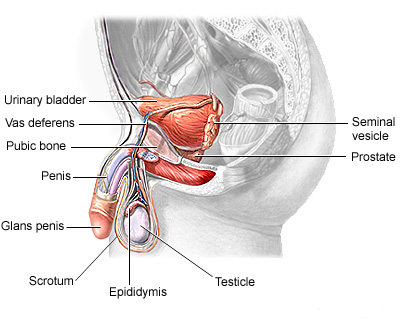Phimosis and paraphimosis
Contents
What Is It?
In an uncircumcised male, the head of the penis is covered by a sheath of skin known as the foreskin. Phimosis is a condition in which the foreskin is tightly stretched around the head of the penis and cannot be pulled back freely. Phimosis can occur naturally. For example, in boys younger than age 4, it is normally hard to pull back the foreskin. However, in older boys and men, phimosis often is triggered by an infection under the foreskin (balanitis) or by other medical conditions such as diabetes.
Paraphimosis occurs when a tight foreskin is pulled back behind the head of the penis and then becomes stuck. It cannot be placed forward again to its usual position covering the tip of the penis. This can cause swelling, pain and loss of blood flow to the tip of the penis. If the foreskin cannot be pushed back into its natural position, serious harm can occur.
Male reproductive system
Symptoms
Phimosis is usually painless. However, a very tight foreskin may interfere with urination or sexual function. In addition, phimosis may make it difficult for a man to clean under the foreskin, which can make infection of the skin more likely.
Paraphimosis usually results in painful swelling of the foreskin and head of the penis. Severe loss of blood flow to the head of the penis may be signaled by a deep purple color, which usually indicates a medical emergency.
Diagnosis
A doctor can diagnose phimosis and paraphimosis during a physical examination.
Expected Duration
Phimosis in a young child is likely to improve on its own. In adults, phimosis will not go away unless surgery is done or an infection is treated.
Prevention
Phimosis may be prevented by good hygiene. This includes fully pulling back the foreskin, so you can clean under it during bathing.
Paraphimosis can be prevented by carefully replacing the foreskin every time it is pulled back. If paraphimosis occurs, circumcision may be recommended to prevent it from happening again.
Treatment
Phimosis without any symptoms does not require treatment. This is especially true in children. If a boy does not outgrow phimosis or there are problems with urination or hygiene, treatment with certain medicated creams, such as hydrocortisone, may be effective.
In some older boys and men with phimosis, good hygiene and prompt treatment of infections may be all that is needed to prevent problems. In other men, persistent symptoms occur, and corrective surgery (circumcision) needs to be done.
It is an emergency if paraphimosis occurs and the foreskin cannot be pushed back into its normal position. A physician may need to do an emergency procedure to create a slit in the foreskin, or do circumcision.
When to Call a Professional
Call your doctor if you:
- Have difficulty pulling back or cleaning under your foreskin
- Develop an infection under the foreskin
- Pull back your foreskin and cannot push it back into its normal position
Prognosis
In most men, phimosis is not a serious problem and will not require treatment. However, it is not expected to improve on its own.
As noted above, paraphimosis is sometimes a medical emergency, and the penis may become permanently damaged if you do not seek immediate medical attention


